Freight Forwarder Insights
Huin International Logistics Latest Articles
What Are the Stages in the Air Freight Forwarding Process?
Understanding which goods are permissible for air transport is only the beginning. The next crucial step is to consult with a freight forwarder for up-to-date flight schedules. This information typically encompasses flight frequency (initial leg, layovers), aircraft type (specific goods may necessitate larger planes, such as B768-408F), aircraft cargo configurations (dedicated cargo planes vs. mixed passenger-cargo aircraft), and associated freight costs (including miscellaneous charges, handling fees, billing fees, fuel surcharges, etc.).
Once the airline confirms flight details, a power of attorney, essentially a contract, is signed with the freight forwarder. Concurrently, export-related documentation must be provided as per the freight forwarder's specifications.
Companies with import and export capabilities generally need to furnish a cargo packing list, commercial invoice, and business contract. Customs clearance involves two main aspects: declaration and inspection. For customs declaration, relevant documentation should be provided according to both the departure and destination countries' requirements. This can be managed either independently or through a freight forwarder.
When the goods are ready, the forwarder pre-books the cargo space based on the information stipulated in the power of attorney. Once this is completed, the customer will receive entry details for the warehouse where the goods need to be sent.
Upon arrival at the airport warehouse, the dimensions and weight of the cargo are verified. Pricing is determined by either the agreed freight rate or the published rate set by the International Air Transport Association (IATA), calculated using the formula lengthwidthheight CM/6000.
After establishing the shipment’s weight, the freight forwarding staff at the airport will label the goods. Office personnel will then prepare and input the shipment’s pre-allocation manifest. If all information is consistent, the customs declaration can proceed. Generally, there are two customs outcomes: full release or partial inspection. Before declaring to customs, you will receive the master airway bill and the bill of lading.
In the case of an inspection, relevant waybill information must be provided as required. Consistency between the goods and documentation usually ensures a smooth process.
Once the air transport document receives the customs release seal, it must be signed by the airline.
After the airline acknowledges and signs the document, the freight forwarder completes the handover process with the airline, handing over the documents for transport arrangement. The shipping department’s staff will then load the cargo according to the space plan. International air freight is typically shipped using containers and pallets. The freight forwarder is responsible for the goods and must track both the flight and the cargo. If the goods cannot be dispatched on time due to reasons such as flight delays, cancellations, or issues with cargo compliance, this information including the waybill number, flight number, and shipping schedule, must be promptly communicated to the customer, along with the necessary documents for the transport agent to ensure smooth handover and receipt.
